All paleontologists remember their first time. Mine was in 1993, during a hot, steamy summer in Atlanta, Georgia. I had just spent the previous month camping in wilderness areas of Wyoming, so coming back to a big city with all of its urban temptations meant I was weak and susceptible to seeking out unusual sources of pleasure. Although I was not quite ready to be taken for such an exhilarating ride, it was an experience I’d never forget. Afterwards, once I had recovered enough to be able think about it, I wanted to do it again.
I am, of course, talking about seeing the film Jurassic Park on a movie screen. Sure, this movie has been around long enough (20 years) that nearly every paleontologist has also watched it on a TV, computer, or mobile device. But there is something about seeing dinosaurs – which, let’s face it, are most famous for their size – shown big. The initial glimpse of a Brachiosaurus munching on the tops of tall trees, a herd of Paralophosaurus ringing a glistening lake, an ill Triceratops dwarfing its human caretakers, the grand entrance of the Tyrannosaurus: all of these “actors” were meant to be seen large, and fill us with awe. It worked. Plot, acting, and science aside, Jurassic Park was, and probably still is, the best movie made for conveying what it would feel like for us humans, separated by a minimum of 65 million years, to see real, living dinosaurs.
“It’s, it’s a dinosaur.” That pretty much said it all in 1993, and still does. But what traces were being made by this Brachiosaurus as it strolled through its all-you-can-eat salad bar, known to you and me as a “landscape”? Please read on.
In 1993, though, I did not have an appreciation for some of the smaller details included in this film, and how my research specialty of ichnology – the study of traces, like tracks, burrows, and nests – was reflected throughout it. What dinosaur traces were included in the movie, and how were these traces used to serve or advance the plot? I also wondered how 20 years of field experience and scholarly research in ichnology might have changed my perceptions of it since that first viewing.
So with the re-release of Jurassic Park in 3-D last week, I decided it was time to view it from an ichnological perspective and share these thoughts with others. After all, my next book, Dinosaurs Without Bones (Pegasus Press), is about dinosaur trace fossils, and written for a popular audience. Also, in between the movie’s first release and now, I wrote two editions of a college textbook on dinosaurs (Introduction to the Study of Dinosaurs). Thus I went to the theater well justified in watching Jurassic Park once more, to see for myself how dinosaur traces were portrayed in the most well-loved of all dinosaur movies. And oh yes, for the fun.
For the sake of simplicity, I’ve divided these traces into two categories: those viewers could directly observe in the film, and others that could be inferred from the dinosaurs’ behaviors. Wherever possible, I also connect traces shown in the movie to research done on dinosaur trace fossils during the last 20 years, giving a broad sense of how far dinosaur ichnology has progressed since 1993.
(Ichnologist’s note: Even though all of the live dinosaurs in the movie were set in the 1990s, the study of their modern traces still qualifies as neoichnology. In contrast, any reference I make to actual dinosaur trace fossils is paleoichnology. Just so you know.)
Dinosaur Traces in Jurassic Park
• Velociraptor hatchling traces. Jurassic Park shows two different but complementary examples of hatchling traces for “Velociraptor.” (I will call this dinosaur Velociraptor throughout this post, but as most dino-philes know, the director, Steven Spielberg, scaled up the Late Cretaceous Velociraptor to maximize its frightfulness. Hence it is actually more like the Early Cretaceous Deinonychus or Utahraptor.)
One is an egg-emergence trace, which is the hole left in an eggshell where a dinosaur broke out of its egg. In this scene, a cooing Velociraptor hatchling pokes its cute little nose out of its egg. (This nose, if everything worked out for it, would some day would be warmed by fresh human viscera.) We first witness this tracemaking in the Jurassic Park laboratory toward the start of the film, the same day most of the protagonists arrive on the island (Isla Nublar). As far as I know, such trace fossils have not been interpreted from the fossil record, or if they have, they have not been referred to as trace fossils: which they should be.
The next day, after dinosaur paleontologist Alan Grant and his two companions – Lex and Tim Murphy – were sufficiently terrified (and enthralled) by various dinosaur encounters out in the park, they come across a Velociraptor nest. The nest has about 15-20 broken eggs, and the fracture patterns of the eggshells provide clear evidence of hatching. But these traces also had tiny, two-toed tracks leading away from them. The tracks, with two toes studded by digital pads, were typical for deinonychosaurs. However, unlike nearly every theropod track I’ve seen, these tracks lacked claw marks at their ends. (Tsk, tsk, says this nitpicking ichnologist.)
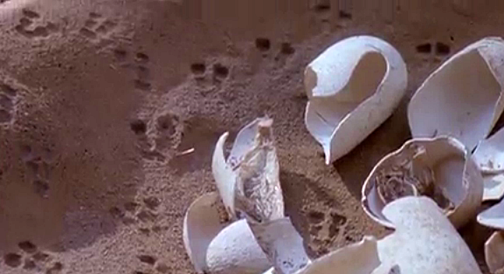 Aw, look at the cute little Velociraptor tracks and hatched eggs. Don’t these traces just make you want to say, “Who’s the cutest little predator in the world?” Still from Jurassic Park (1993), taken from www.anyclip.com.
Aw, look at the cute little Velociraptor tracks and hatched eggs. Don’t these traces just make you want to say, “Who’s the cutest little predator in the world?” Still from Jurassic Park (1993), taken from www.anyclip.com.
Even though these tracks were flashed on the screen for only a few seconds, what’s really cool is how they convey three important pieces of information. One is that the Velociraptor chicks hatched after the torrential rainstorm of the previous night, and thus only mere hours before our wandering heroes saw their traces. Second, the tracks demonstrate that the hatchlings were not altricial, but ready to move and leave the nest immediately, presumably without parental care. Third, Dr. Grant realizes that these successfully fertilized and hatched eggs mean the “female-only” genetic fail-safe plan for the dinosaurs just got disproved. In other words, these traces mattered.
One point about that nest: as far as I could tell from, this Velociraptor mother did not make a rimmed structure to protect the eggs, such as those made by another Late Cretaceous theropod, Troodon, or Late Cretaceous sauropods in Argentina. Instead, the eggs were laid out in the open, like some ground-nesting shorebirds might do. In contrast, the Jurassic Park sequels featured Velociraptor nests that were much more overt as traces, such as a rimmed nest seen in Jurassic Park III.
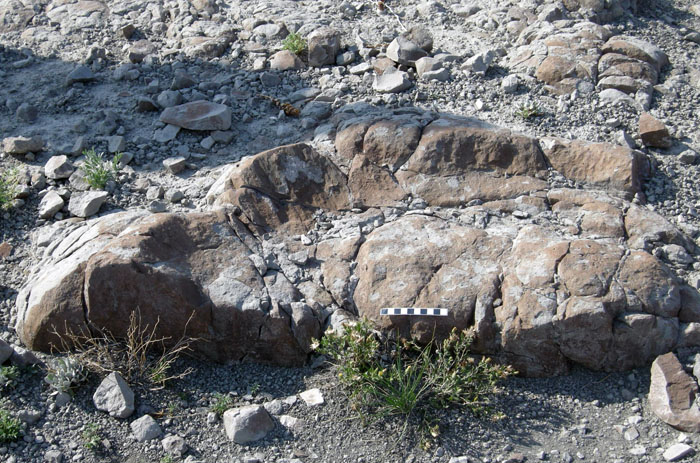 Partially preserved rimmed nest structure of Troodon, a Late Cretaceous theropod that lived in what we now call Montana. The rim has eroded quite a bit since its discovery in the mid-1990s; the Troodon egg clutch was in the area of the foreground before its extraction. (Photograph by Anthony Martin; scale in centimeters.)
Partially preserved rimmed nest structure of Troodon, a Late Cretaceous theropod that lived in what we now call Montana. The rim has eroded quite a bit since its discovery in the mid-1990s; the Troodon egg clutch was in the area of the foreground before its extraction. (Photograph by Anthony Martin; scale in centimeters.)
• Triceratops feces. “That is one big pile of sh*t,” observes Dr. Ian Malcolm, the “chaotician” (mathematician) who supplies both pessimism and comic relief throughout the movie. In this scene, where the main protagonists attend to an under-the-weather Triceratops, two impressive piles of fecal material inspire Dr. Ellie Satler, a paleobotanist, to figure out whether or not the ceratopsian had eaten any toxic plants.
Somehow I suspect this scene was meant as a metaphor for what most paleontologists have to do in their day jobs in order to do any paleontology at all.
Still, when added together, this amount of still-moist waste was far too voluminous to have been from one or two depositional events: I mean, this dinosaur was sick, but not that much. As a result, park personnel must have been responsible for making these dung heaps from several days worthy of Triceratops contributions. (Strictly speaking, then, these heaps were composite traces.) If so, this would have been a rather unenviable job, but maybe they were better paid than Dennis Nedry, the disgruntled computer programmer who later provided ample fodder for Dilophosaurus.
Unfortunately, fossil Triceratops feces (coprolites) are thus far unknown from the geologic record. What is exciting, though, is that several excellent studies have been done by Dr. Karen Chin on Late Cretaceous hadrosaur coprolites. These coprolites, like the fictionalized Triceratops feces, contain lots of plant material, telling us much about what these hadrosaurs ate 75 million years ago. They also tell us what ate the feces or grazed on them, which were dung beetles and snails, respectively. (Indeed, I now wonder if Isla Nubar had a severe shortage of dung beetles, which might explain how those Triceratops feces got piled higher and deeper.)
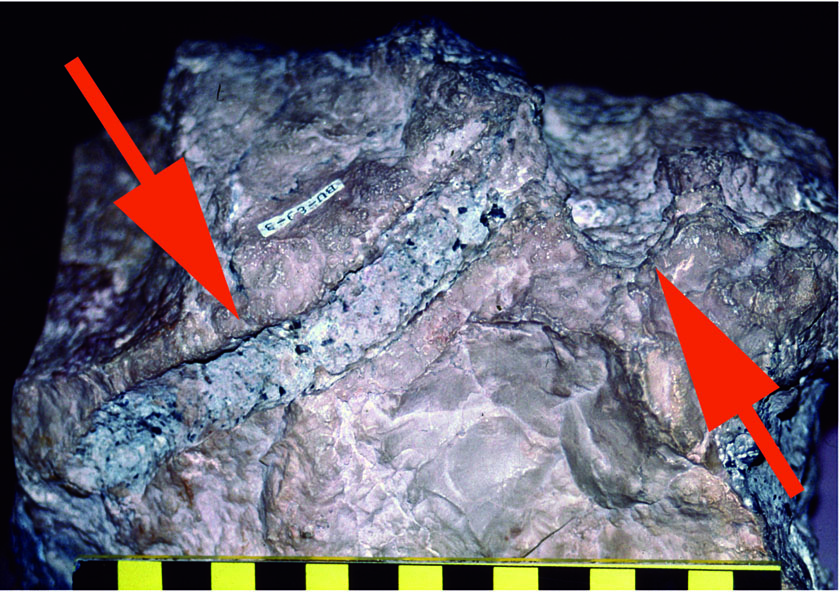 Dinosaur coprolite – probably from a large hadrosaur, such as Maisaura – and filled with wood fragments, accompanied by special bonus trace fossils: dung beetle burrows! Specimen from the Two Medicine Formation (Late Cretaceous, Montana) as part of a Museum of the Rockies traveling exhibit at Fernbank Museum of Natural History. (Photograph by Anthony Martin, taken in 2001 and scanned from a 35-mm slide; scale in centimeters.)
Dinosaur coprolite – probably from a large hadrosaur, such as Maisaura – and filled with wood fragments, accompanied by special bonus trace fossils: dung beetle burrows! Specimen from the Two Medicine Formation (Late Cretaceous, Montana) as part of a Museum of the Rockies traveling exhibit at Fernbank Museum of Natural History. (Photograph by Anthony Martin, taken in 2001 and scanned from a 35-mm slide; scale in centimeters.)
• Tyrannosaurus tracks. Probably the most memorable scene in Jurassic Park is the grand entrance of the Tyrannosaurus, whose approach is first detected by “impact tremors” transmitted in cups of water on the dashboard of a jeep. Following this first bout of terror and the arrival of Ellie Sattler and big-game hunter Robert Muldoon, Malcolm, convalescing in the back of a jeep, looks down at a three-toed Tyrannosaurus track. The track, filled with water from the rain, communicates a warning as it vibrates from the footfalls of the approaching giant theropod. This repeats the previous image of the trembling water in the cup, but is made doubly dreadful by happening in a freshly made footprint of the same animal causing the tremors.
So what was by far the most exciting moment in the movie for me, ichnologically speaking? The Tyrannosaurus making a track, in which mud pushes up and out to the sides of its right foot, observed at 2:38 in the following video clip. Just watch:
This was already a great scene for all of its action, suspense, and lawyer eating. But check out that track-making!
Only a few fossil tracks have been attributed to Tyrannosaurus or other tyrannosaurids, mostly for being the right size (really big) and geologic age (Late Cretaceous). One was discovered in New Mexico in 1983, but wasn’t reported in a scientific journal until the year after Jurassic Park came out. More than a decade passed before another was found in Montana in 2007 and reported in 2008. Tragically, both were isolated tracks, and a Tyrannosaurus trackway, with two or more consecutive steps, has not yet been found. If so, it would make for a pretty darned nice find. So please do let the world know if you find one.
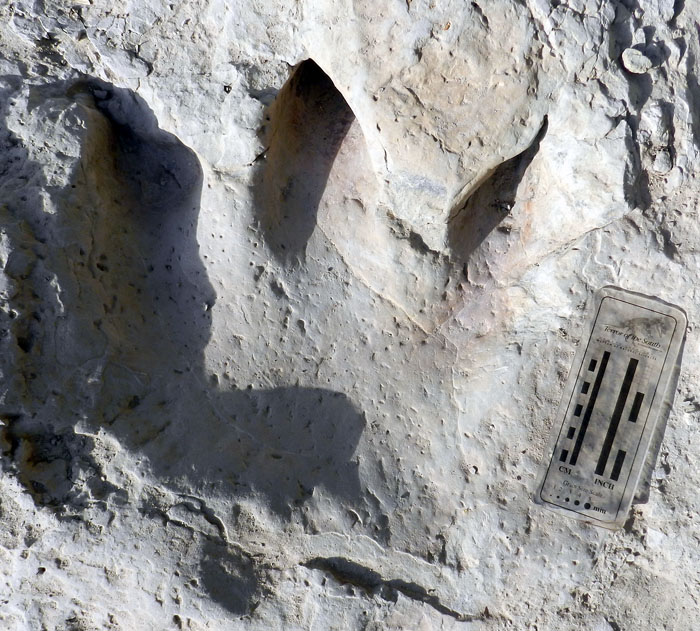 A large and well-preserved three-toed theropod track from the Early Cretaceous Glen Rose Formation of Texas, made about 95 million years ago. Although this track was more likely made by Acrocanthosaurus, rather than Tyrannosaurus rex, you can be assured that this theropod, like all living things, was a distant relative of T. rex. (Photograph taken by Anthony Martin; scale in centimeters.)
A large and well-preserved three-toed theropod track from the Early Cretaceous Glen Rose Formation of Texas, made about 95 million years ago. Although this track was more likely made by Acrocanthosaurus, rather than Tyrannosaurus rex, you can be assured that this theropod, like all living things, was a distant relative of T. rex. (Photograph taken by Anthony Martin; scale in centimeters.)
• Velociraptor tracks (adults). These tracks, shown only for a few seconds, are outside of the Velociraptor enclosure after the power was shut down. Muldoon, accompanied by Sattler, spots the footprints, and he wordlessly identifies them. (His expression also tells the audience that Sattler and he are going to be in deeper doo-doo than the Triceratops piles.) The twisted and broken bars of the enclosure provide additional traces affirming the conclusion that these ‘raptors are on the loose. All of these traces are shown only minutes before Muldoon utters his meme-inspiring last words, “Clever girl.”
![]() Uh oh: Velociraptor tracks, and these don’t look like they’re from hatchlings. Good thing Muldoon is a big-game hunter, who’s skilled at tracking and predicting Velociraptor behavior based on their tracks. But too bad his hypothesis was falsified in such an unpleasant way, but I suppose he could have picked kinder reviewers. Still from Jurassic Park (1993), taken from www.anyclip.com.
Uh oh: Velociraptor tracks, and these don’t look like they’re from hatchlings. Good thing Muldoon is a big-game hunter, who’s skilled at tracking and predicting Velociraptor behavior based on their tracks. But too bad his hypothesis was falsified in such an unpleasant way, but I suppose he could have picked kinder reviewers. Still from Jurassic Park (1993), taken from www.anyclip.com.
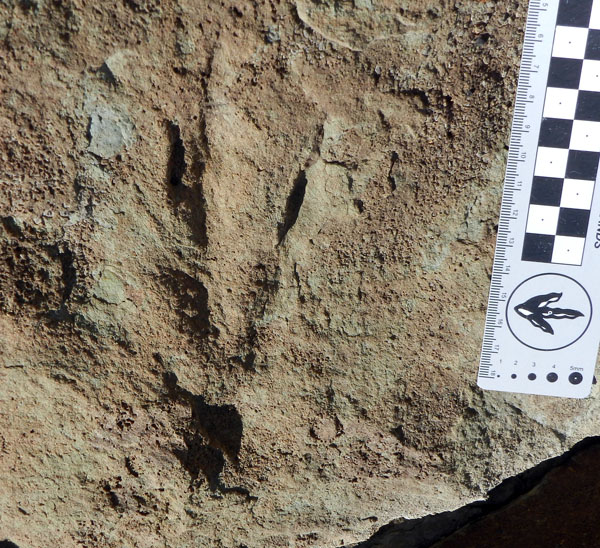 Here’s what a real deinonychosaur track looks like. This one, from the Early Cretaceous of Utah, is a right foot impression, and is just slightly smaller than the adult tracks depicted in Jurassic Park. Notice the digits are thinner and end with sharp clawmarks, too. (Photograph by Anthony Martin; scale in centimeters.)
Here’s what a real deinonychosaur track looks like. This one, from the Early Cretaceous of Utah, is a right foot impression, and is just slightly smaller than the adult tracks depicted in Jurassic Park. Notice the digits are thinner and end with sharp clawmarks, too. (Photograph by Anthony Martin; scale in centimeters.)
• Bioerosion of fossil dinosaur bones by modern dinosaurs. Toward the end of the film, the main human heroes – Grant, Sattler, Murphy, and Murphy (which sounds like a law firm, but we know how T. rex feels about those) – are confronted by a Velociraptor pack in the Jurassic Park visitor center. During their attempts to flee the ‘raptors, both species end up disarticulating and breaking some of the mounted dinosaur skeletons in the atrium of the visitor center. Their actions were thus a form of bioerosion, in which the fractured dinosaur bones are traces of their activities. Alternatively, the bones may have been artificial casts, in which case their breakage would have constituted bioerosion of modern substrates.
This bioerosion is made more complicated when the Tyrannosaurus rex (who everyone agrees is the ultimate protangonist of the movie) enters the atrium and, among other antics, smashes a skeleton of itself with a recently crunched Velociraptor. As a result, the jumbled assemblage of bones at the end is attributable to three separate, interacting tracemakers: four humans (two adult, two juvenile), two Velociraptors (both adults), and one Tyrannosaurus (adult). What should be noted, though, is that if the Velociraptor was already dead when flung by the Tyrannosaurus, then the broken skeleton is a trace of the Tyrannosaurus, not the Velociraptor. In other words, the Velociraptor body was just being used as a tool.
Bioerosion in action, as a result of Velociraptor and human interactions. Also, at 2:45: T. rex smash!
Dinosaur Trace-Making Behaviors in Jurassic Park
• Brachiosaurus tracks, browsing traces. When Drs. Grant and Sattler experience their first jaw-dropping glimpse of a Brachiosaurus, they watch it rear up on its hind feet, and come down hard on front feet. Considering that a Brachiosaurus this size might have weighed at least 30 tonnes, it surely would have left deep tracks in both the front and rear from the increased stresses imparted by these actions. Also, its cropping the tops of trees would have caused some easily visible gaps in the canopies of forests on Isla Nubar.
• Theropod toothmarks. Part of the fun of Jurassic Park was indulging in our worst nightmares about these non-avian theropods frequently sampling human flesh. Assuming that the theropod teeth in each instance penetrated skin and muscle and contacted bone, toothmarks would have included the following: (1) Tyrannosaurus toothmarks on goat, human, and Velociraptor bones; and (2) Velociraptor and Dilophosaurus toothmarks on human bones.
• Triceratops resting trace. When the paleontologists and others visit the ailing Triceratops, it was lying on its right side. I couldn’t help but think that if Triceratops or any other large ceratopsian dinosaur ever reclined like that, and in the right type of sediment, it would have left a gorgeous body impression. This scene also reminded me of bison traces I’ve seen in Yellowstone National Park, in which bisons roll onto their sides for a dust bath, leaving outlines of their bodies. Did dinosaurs – especially the feathered ones – ever take dust baths, and leave similar body impressions? We don’t know yet, but such trace fossils are something to look for.
• Dinosaur stampede. One of the most astonishing computer-generated effects of Jurassic Park, and one that was especially effective in 3-D, was of a dinosaur stampede. In this scene, a flock of Gallimus run toward and around Grant, Murphy, and Murphy, just before the ambush-hunting Tyrannosaurus rex slaughters one of them (the Gallimus, that is). I’ve written about this scene before, connecting it to a dinosaur tracksite in Queensland, Australia that has more than 3,000 tracks preserved. Although the site was originally interpreted as the only evidence of a dinosaur stampede, the tracks were recently reinterpreted as swim tracks. I’ll write about this topic at length in my upcoming book, so for now, I ain’t saying nothing more.
Run away, run away!
• Tyrannosaurus drag mark. After the Tyrannosaurus rex decides that a measly goat was just an appetizer and begins seeking out the nearest available mammals for nomming purposes, at some point it overturns and begins pushing an SUV, which still has Lex and Tim Murphy trapped underneath it. Its flipping the SUV with its head certainly would have left a substantial mark on the muddy ground, a trace that then would have been connected to a semi-circular dragmark (clockwise oriented), and with tracks directly adjacent to these traces. Her tracks also may have been deeper in their fronts because of her head being down as she pushed, reflecting a shift in her weight distribution. However, I should again remind everyone that just like with the dead Velociraptor used for bioerosion by this same T. rex later in the film, the SUV is not making the trace. It is only a tool being used by the tyrannosaur, which is the real tracemaker.
• Tyrannosaurus running trackway – This pulse-quickening chase scene, in which the T. rex pursues a jeep driven by Muldoon and with Malcolm and Sattler as passengers, very likely would have caused a wonderful sequence of tracks. These tracks would have shown increasing stride lengths from a standing start to full-speed run, and each successive track would have registered external and internal structures consistent with this acceleration. Even better, the tracks would have cross-cut the jeep tire-tracks at some points, demonstrating to a later observer that the tyrannosaur was very likely following the jeep. (The demolition of a low-hanging tree branch by the T. rex during the chase also counts as some bioerosion along the way.) Some convincing studies have been done since showing that an adult Tyrannosaurus could not have moved as fast as the one in Jurassic Park, but it still could have caught most running humans. And just to repeat what I said earlier, it’d be really nice for someone to find a T. rex trackway, which would give us more direct evidence of how these massive theropods moved.
• Velociraptor scratch marks and other traces. This time, while watching the harrowing and claustrophobic scene in which a pair of Velociraptors hunt the Murphy siblings in a kitchen, I started thinking about the traces they might have left. Did their claws leave scratch marks on the door handles and kitchen counters? Did they indent the steel counters when they jumped up on these surfaces? A broken window is also shown as a trace of their smashing through glass once they became frustrated with a locked door.
OK, enough of the fanciful ichnology. What about other dinosaurs and their traces? Well, it turns out that Jurassic Park saved the real, living dinosaurs for the very end of the movie. These were five brown pelicans (Pelecanus occidentalis), flying in formation as Grant, Sattler, and their companions leave Isla Nubar in a helicopter. For Grant, this is a poignant moment, as he is likely reflecting on how dinosaurs were still with us today as birds. With that thought, I will say “amen,” and add that dinosaur traces – tracks, nests, feces, bite marks, and all – are still here with us, too, and don’t require special glasses to see them in three dimensions. Thanks for that reminder, Jurassic Park.
 Want to see some modern dinosaur traces? Here are tracks of a brown pelican, made in wet sand while it was loafing on a beach at low tide on Sapelo Island, Georgia. To see more modern dinosaur traces, just go outside, and you’ll find them wherever birds are found. (Photograph by Anthony Martin; scale in centimeters.)
Want to see some modern dinosaur traces? Here are tracks of a brown pelican, made in wet sand while it was loafing on a beach at low tide on Sapelo Island, Georgia. To see more modern dinosaur traces, just go outside, and you’ll find them wherever birds are found. (Photograph by Anthony Martin; scale in centimeters.)
Further Reading
Chiappe, L.M., Schmitt, J.G., Jackson, F., Dingus, L., and Grellet-Tinner, G. 2004. Nest structure for sauropods: sedimentary criteria for recognition of dinosaur nesting traces. Palaios, 19: 89–95.
Chin, K. 2007. The paleobiological implications of herbivorous dinosaur coprolites from the Upper Cretaceous Two Medicine Formation of Montana: why eat wood? Palaios, 22: 554-566.
Chin, K., and Gill, B.D. 1996. Dinosaurs, dung beetles, and conifers: participants in a Cretaceous food web. Palaios, 11: 280-285.
Elbroch, M., and Marks, E. 2001. Bird Tracks and Sign of North America. Stackpole Books, Mechanicsburg, Pennsylvania.
Erickson, G. M., Van Kirk, S. D., Su, J., Levenston, M. E., Caler, W. E., & Carter, D. R. 1996. Bite force estimation for Tyrannosaurus rex from tooth-marked bones. Nature, 382: 706–708.
Gignac, P.M., Makovicky, P.J., Erickson, G.M., and Walsh, R.P. 2010. A description of Deinonychus antirrhopus bite marks and estimates of bite force using tooth indentation simulations. Journal of Vertebrate Paleontology, 30: 1169-1177.
Hutchinson, J.R., and Garcia, M. 2002. Tyrannosaurus was not a fast runner. Nature, 415: 1018-1021.
Jacobsen, A.R. 1998. Feeding behaviour of carnivorous dinosaurs as determined by tooth marks on dinosaur bones. Historical Biology, 13: 17-26.
Lockley, M.G., and Hunt, A.P. 1994. A track of the giant theropod dinosaur Tyrannosaurus from close to the Cretaceous/Tertiary Boundary, northern New Mexico. Ichnos, 3: 213-218.
Manning, P.L., Ott, C., and Falkingham, P.L. 2008. A probable tyrannosaurid track from the Hell Creek Formation (Upper Cretaceous), Montana, United States. Palaios, 23: 645-647.
Martin, A.J. 2013. Life Traces of the Georgia Coast: Revealing the Unseen Lives of Plants and Animals. Indiana University Press, Bloomington, Indiana: 692 p.
Romilio, A., and Salisbury, S.W. 2011. A reassessment of large theropod dinosaur tracks from the mid-Cretaceous (late Albian–Cenomanian) Winton Formation of Lark Quarry, central-western Queensland, Australia: a case for mistaken identity. Cretaceous Research, 32: 135-142.
Romilio, A., Tucker, R., Salisbury, S. 2013. Reevaluation of the Lake Quarry dinosaur tracksite (late Albian-Cenomanian Winton Formation, central-western Queensland, Australia): no longer a stampede? Journal of Vertebrate Paleontology. 33: 1, 102-120.
Sellers, W.I., and Manning, P.L. (July 2007). Estimating dinosaur maximum running speeds using evolutionary robotics. Proceedings of the Royal Society of London, B, 274: 2711-2716.
Thulborn, R.A., and Wade, M., 1979. Dinosaur stampede in the Cretaceous of Queensland. Lethaia, 12: 275-279.
Varricchio, D.J., Jackson, F. and Trueman, C.N. 1999. A nesting trace with eggs for the Cretaceous theropod dinosaur Troodon formosus. Journal of Vertebrate Paleontology, 19: 91-100.
